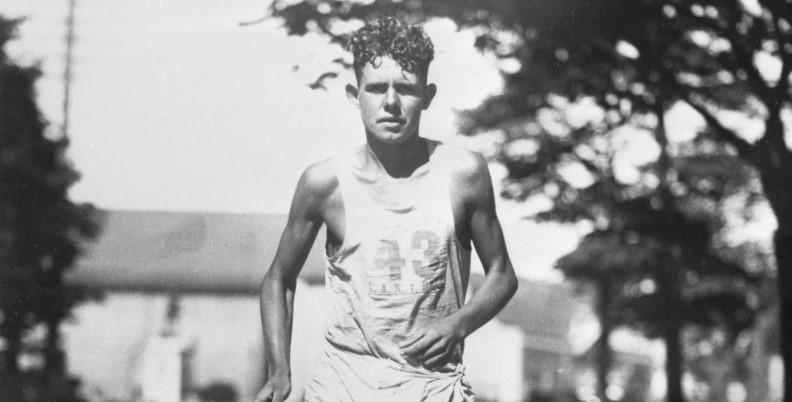
Andy Payne, Winner of the Transcontinental Footrace
The Transcontinental Footrace of 1928 was a daring event, putting hundreds of men to the test of endurance, speed, and determination. This race was organized by the nation’s first sports agent, Charles C. Pyle. It was set to begin on March 4th, 1928 in Los Angeles and finish some time in May in New York City, with a first place prize of $25,000 (adjusted for inflation, that would be over $411,000 today).
The trail would follow Route 66 from the starting point to St. Louis, bringing the racers right through Springfield. The total distance was over 3,400 miles in less than three months. There would be a slough of cars to follow along the race, including support teams, journalists, a shoe repairman, and the first mobile radio station. Race participants would have to sleep in tents along the way, and food would be served once a day in a chow-line fashion. The chambers of commerce in towns along the way would pay Pyle for the opportunity to have the runners stop in their town, and he would even set up carnivals at some points to take advantage of the crowds. At these carnivals, the runners could earn money by selling race programs and autographs.
Andy Payne was always a runner. The 20 year old Cherokee man had been running for fun and transport since he was a child, and won several awards during his track career in high school. In his hometown of Claremore, Oklahoma, Payne received financial backing from his parents and the Chamber of Commerce to cover the entry fee. He trained on the back roads of eastern Oklahoma in any weather conditions, and developed a running style his father described as “a machine-like trot that keeps him moving but doesn’t hurt him.”
Payne arrived in Los Angeles in January of 1928 and began to run 1-30 miles a day. He and the 275 other runners spent the weeks leading up to the race sleeping in tents and eating food from Pyle’s cooks in order to prepare for the conditions of the race. Men of all backgrounds came from all around the world to participate.
Seventy-seven men dropped out of the race on just the first day. So many runners developed foot problems a week into the competition that it was nicknamed “The Bunion Derby.” By this point, only 145 runners remained, and as more dropped out due to injuries, Payne became the leader. He persisted even when he was diagnosed with tonsillitis. As the race made its way into Oklahoma, people ran alongside Payne, snagging autographs and pictures of the local hero. In Oklahoma City, the governor cheered him on, and in Payne’s hometown of Claremore, Will Rogers was in the crowd applauding for the young man.

This photograph shows runners in the Trans-Continental Footrace running through Springfield, MO in 1928. The photograph was taken at the intersection of St. Louis Street and Jefferson Avenue, looking west towards St. Louis Street. This photograph is part of the History Museum on the Square’s archives.
As the race continued into Illinois, traffic became a major issue for the runners. Several dropped out from injuries caused by minor accidents involving cars and motorcycles, or from the fear of being the next one hit. By the time they reached the final leg of the journey in New York City, there were only 55 runners left.
Andy Payne was victorious, leading the charge to Madison Square Garden, the final destination of the race. It took 5 pairs of shoes and 573 hours to cover the 3,422.3 miles. Payne used the $25,000 first place prize money to pay off the mortgage on the family farm, build a new home, and invest in land in northeastern Oklahoma. Quite luckily, gas and oil were discovered on his newly purchased land. He retired from competitive running once the race was finished, and worked as the Clerk of the Supreme Court of Oklahoma from 1934 to 1972. He died suddenly in 1977, and Oklahoma City honors him each year with the Andy Payne Memorial Foot Races. Claremore erected a statue in his honor along Route 66, depicting the hometown hero as he ran the Transcontinental Footrace.
Written by Meg Pearson, 2022. The image of Andy Payne running in the race featured in this image is from the Claremore Museum of History in Claremore, Oklahoma. https://claremoremoh.org/the-andy-payne-exhibit/